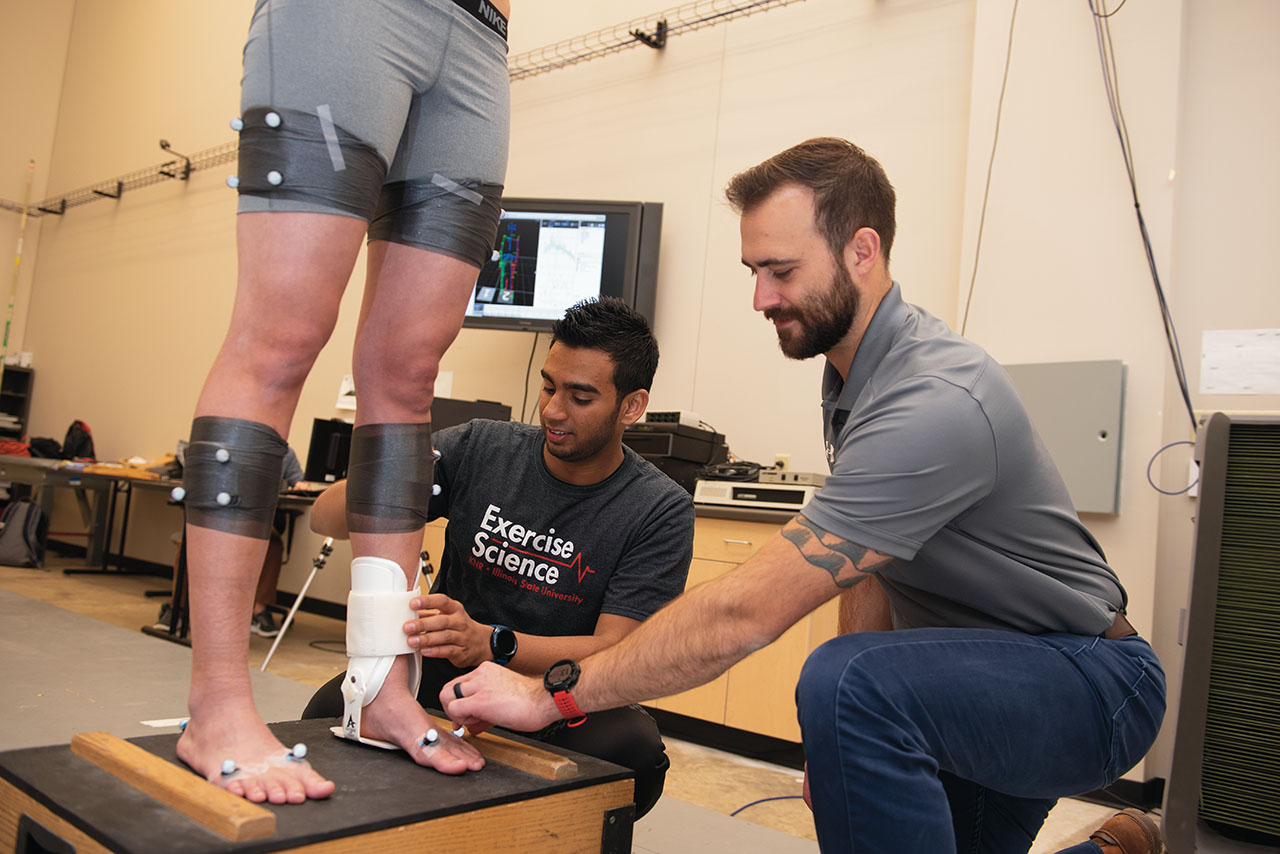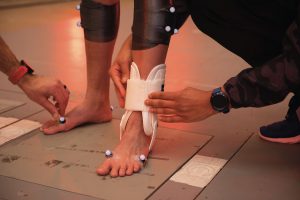Mohammed Zaman heard a crack. And as he lay on the gym’s hardwood floor, he knew he had just severely sprained his ankle playing basketball. What Zaman, then in high school, did not know was that his injury would lead him to what he is currently researching today.
Zaman soon became interested in the remedy that helped him recover from his injury: ankle braces. Since his freshman year at Illinois State, Zaman, an exercise science major, has been immersed in researching ankle braces with Assistant Professor Adam Jagodinsky, of the School of Kinesiology and Recreation.
Appears InAnkle braces are used to help heal and prevent an ankle sprain, the most common type of musculoskeletal injury. Bracing a joint has several different effects on the body, but the most obvious one is that the joint typically has less range of motion. This helps prevent ligaments and tendons from being strained during movement. However, braces can alter information sent from sensors in the joint to the brain and spinal cord about how one’s body is moving. This sensory information is very important for determining how movement is controlled during complex movements and simple movements, such as standing.
The researchers have been seeking to understand how different types of ankle braces affect a person’s control of movement while standing. When humans stand, our bodies subtly sway, a movement we subconsciously control. Jagodinsky and Zaman’s research examines how different ankle braces affect characteristics of subtle sway patterns. Specifically, they want to know whether wearing one ankle brace over another causes someone to have more or less movement or sway.
“We know that there’s a difference between those who have had ankle injuries and worn ankle braces as opposed to those who have never had an injury,” said Zaman. Yet, the pair were interested in how people who haven’t previously experienced an ankle injury would respond to wearing different types of ankle braces.
To conduct the study, the researchers had Illinois State students enter a lab, put on an ankle brace, and stand on a force plate, which is a device that measures reaction forces created by somebody moving or standing upon them. The subjects participated in three different trials for three types of bracing conditions while Zaman and Jagodinsky measured weight shifting and how much the subject’s center of gravity moved back and forth.
Jagodinsky and Zaman found that rigid ankle braces cause the body sway patterns to be significantly more constrained compared to soft ankle braces or no ankle brace. Jagodinsky said more constrained movement control resulting from ankle bracing could be important for preventing ankle injuries, but may also make movements less adaptable to certain environments.
“If you know that you want to pursue a career that you’re heavily invested in, you want to do due diligence of looking out and finding those research opportunities and know that the faculty is there to support you.”—Mohammed Zaman
Zaman said the most important aspect of the research is that it is applicable. “You’re doing something that you can tell people and they can understand.”
Zaman has shared his research at the Illinois State University Research Symposium; the Illinois Association for Physical Education, Health, Recreation, and Dance (IAHPERD) Conference; and the American College of Sports Medicine (ACSM) National Conference.
At last April’s Research Symposium, Zaman met Associate Professor and Office of Student Research (OSR) Director Gina Hunter. She invited Zaman to join the OSR’s Advisory Board.
Hunter launched the office last fall to facilitate, support, and highlight undergraduate and graduate student research on campus. The office’s board—composed of faculty, students, and staff from across campus—provides Hunter with feedback and recommendations.
“The student perspective on the board is very important as we want to engage students and understand their perspective and concerns in taking on research projects,” said Hunter.
Zaman said there is a substantial need for student researchers on campus.
“I think a lot of faculty want students to get involved but are not finding enough traction to attract members,” said Zaman. “I’ve been in classes where faculty specifically tell us that they are looking for researchers. I think there is a need, and having this Advisory Board will help bridge that gap, but ultimately, it will be up to the students if they want to pursue research at the end of the day.”
Jagodinsky believes it is valuable for students to partake in research because they get the opportunity to apply what they learned in the classroom to solve a problem.
“In Mohammed’s case, he was able to take a leadership role and learn about organization, time management, and other skills that are going to help him moving forward,” Jagodinsky said.
Zaman is working on his first peer-reviewed publication with Jagodinsky. Since last spring, the two have been working on drafts based on their ankle bracing study and research Zaman has compiled from relevant articles.
Zaman graduated from Illinois State in December. He planned to attend medical school.
Zaman chose Illinois State, in part, for the opportunity to connect with professors, which is made possible by the University’s low student to faculty ratio. He encouraged other students to make the most of their time at the University.
“If you know that you want to pursue a career that you’re heavily invested in, you want to do due diligence of looking out and finding those research opportunities and know that the faculty is there to support you,” he said.



I was particularly interested in Mr. Zaman’s ankle research, since I also did research on ankle braces when a Professor in KNR and Director of the Athletic Training Education Program. We eventually developed the Tace Brace, which was attached to the athletic shoe, and sold the patent rights to Reebok. Since them several similar shoe companies have developed shoes (Nike) with similar straps to limited ankle sprains. Very interested in Mr. Zaman’s research methodology. Good work. Congratulations!